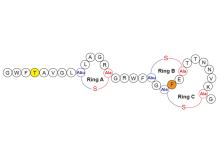BACKGROUND
Dental diseases are often caused by a perturbation in the balance of the oral microbiome. Bacterial species that confer positive health benefits may reduce in number shifting the oral composition to more virulent strains and increasing the chance of disease. This harmful shift can be reversed by using commensal bacteria to target and crowd out these pathogens. Streptococcus salivarius is one such organism that secretes modified peptide antibiotics (i.e. lantibiotics) against several different pathogenic species, consequently leading to the commercial development of two oral probiotic strains (K12, M18) by BLIS Technologies. However, these strains are mainly targeting bacterial species that cause halitosis, strep throat, and for a lesser extent, dental caries.
TECHNOLOGY
Researchers at the University of Toronto have isolated a Streptococcus salivarius strain (SALI-10) that can secrete a tandem array of lantibiotics (Figure 1) that can interfere with the growth of periodontal pathogens, including P. gingivalis and T. forsythia and the multi-drug resistance (MDR) pathogens like S. pneumoniae and E. faecalis, all that without affecting the core commensal and indigenous microbiota of the oral cavity. The peptides are encoded in a megaplasmid which additionally contains several peptide-modifying enzymes. The primary antimicrobial mode of action of the lantibiotics occurs through membrane disruption and pore formation at the cytoplasmic membrane of bacterial cells. The novel lantibiotics of S. salivarius SALI-10 were shown to sensitize neutrophils and macrophages in a symbiotic fashion to produce anti-inflammatory responses and induce phagocytosis to bring about multi-levels of protection against infectious diseases.
Figure 1. Structure of one of the three lantibiotics in Salivaricin 10. Two β-methyllanthionine rings (Abu-S-Ala) and one lanthionine ring (Ala-S-Ala) are shown.
COMPETITIVE ADVANTAGE
- Potent antibiotic
- Minimal inhibitory concentration in the micromolar range (0.125-64 μg ml−1 for Gram-positive bacteria and 32-64 μg ml−1 for Gram-negative bacteria)
- Immunomodulatory Activity
- Increased phagocytosis
- 50% – 75% increase in phagocytosis by neutrophils and monocytes
- Polarizes monocytes towards M2 pro-resolution phenotype and reduces inflammation
- Increased production of reactive oxygen species to clear bacterial pathogens
- Chemotactic peptides, induce chemotaxis by neutrophils
- Increased phagocytosis
- Effective penetration of biofilms
- 6-fold decrease in live/dead cell ratio
- 20% reduction in biofilm thickness
- 2-fold reduction in roughness (i.e. heterogeneity of bacterial distribution)
- Targeting pathogens while maintaining commensals
APPLICATIONS
- Oral and upper respiratory tract infections
- Periodontal disease
- Antibiofilm
- Anti-inflammation
INTELLECTUAL PROPERTY STATUS
- Provisional patent application filed (Feb 2022)
PROJECT STATUS
A S. salivarius strain (SALI-10) containing three lanthipeptides was isolated from a set of 78 strains collected from healthy human adults. The SALI-10 genome was sequenced, and the peptides were isolated and structurally characterized using high-resolution mass spectrometry and 2-D NMR. The antibiotic potential of SALI-10 was ascertained by testing it against 24 different pathogenic bacterial species and multispecies biofilm, while its immunomodulatory potential was tested using neutrophils and monocytes.






